

(this is Chapter 19 of Adventures in Physics, available only online)
Ch 19, Optical Instruments; 1 through 10
![]()
Homework for Chapter 19, Optical Instruments
1. As the aperature in a pin-hole camera increases, the image becomes brighter but will no longer be in focus. A lens is now necessary. Explain what the lens does.
As the pin-hole becomes larger, light that originated from a tiny point on the object is allowed to spread out to a large circle on the image. This makes the image fuzzy. A lens focuses the light that originated from a tiny point on the object back down to a tiny point on the image. This means the image is sharp or clear.
2. What is meant by "depth of field"? How or why does "depth of field" depend upon the lens opening?
"Depth of field" is the distance over which an object will still produce a reasonable or acceptably sharp image. That is "depth of field" is the range of object distances that still produce an image distance that corresponds to the location of the film.For a tiny pin-hole camera, with a tiny opening, the depth of field is infinite. As the lens opening (call the apeture) gets larger, the depth of field gets smaller and smaller.
3. If you focus first on a person near a camera and then focus on the background far away, do you move the camera's lens toward the film or away from the film?
As the object moves farther from the lens or as the object distance increases, the image distance must decrease or we must move the film and lens closer to each other.
4. When a lens is used to help a nearsighted person see a distant object, what kind of image is produced by this lens and where is it located?
The lens produces a virtual image that is closer to the eye than the actual object is. This new image -- this virtual image -- is closer than the patient's far point. That is, this new image -- this virtual image -- is located in the region in which the patient can see it clearly.
5. In terms of the virtual image produced, explain what effect a converging eyeglass lens has on light reaching the eye. For what kind of vision condition -- nearsightedness or farsightedness -- is this the right corrective lens?
A converging lens can produce a virtual image that is farther away than the object (this was the case for the last experiment you did in the Image Formation lab). This virtual image, then, can be beyond a farsighted person's near point and, thus, be located in the region that such a person can see clearly.
6. When a lens is used to help a farsighted person see a distant object, what kind of image is produced by this lens and where is it located?
The converging lens produces a virtual image that is farther from the eye than the actual object is. This new image -- this virtual image -- is farther than the patient's near point. That is, this new image -- this virtual image -- is located in the region in which the patient can see it clearly.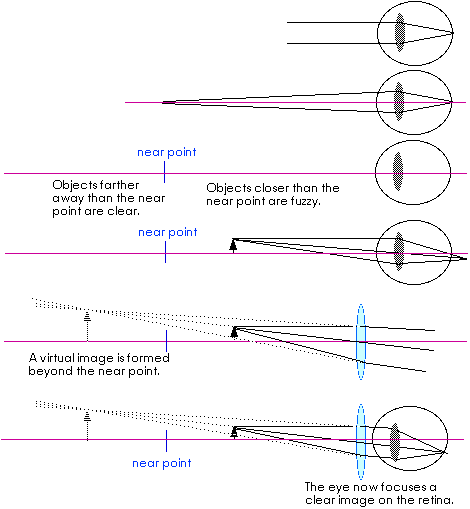
7. Why is your vision sharper or clearer in bright sunlight than in a moderately lighted room?
In bright sunlight, the iris of the eye becomes smaller and your "depth of field" increases. Your eye behaves more like a pin-hole camera. This makes the image on your retina sharper.
8. If a person can clearly see far distant objects and still see them clearly until they are 75 cm away, how would you describe that person's vision? What is their far point? What is their near point? It is more comfortable to read a book when it is about 25 cm away. What sort of eyeglass lenses would allow this person to read a book held about 25 cm away.
The person is farsighted with a near point of 75 cm. Since they can see far distant objects clearly, their far point is infinity. Their near point is 75 cm.When holding a book at 25 cm, we want to form a virtual image that is 75 cm behind the eyeglass lens. This requires a
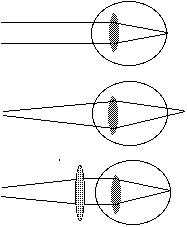
9. If a person can clearly see nearby objects and still see them until they are about 150 cm away, how would you describe that person's vision? What sort of eyeglass lenses will allow this person to see a far-distant billboard?
This person is nearsighted with a far point of 150 cm.Such a nearsighted eye can be helped with a diverging lens.
10. Explain how a simple magnifier works. What kind of lens can be used as a simple magnifier?
A converging lens may be used as a simple magnifier by producing a virtual image at infinity -- or, at least, far away from the eye -- so it can be clearly focused onto the retina.
![]()
Typical multiple-guess questions over this material:
1. Your vision is sharpest when your pupil is
a) dilated or opened wideb) constricted or made tiny
c) blue
d) brown
2. Initially, a camera is focused at some far-distant mountains. It is then adjusted to focus on a nearby person. To do this, the lens
a) is moved closer to the film.b) is moved farther from the film.
c) is "opened" to larger apeture or larger opening.
d) is "shut down" to a smaller apeture or smaller opening.
3. A compound microscope
a) forms a virtual image with its objective lens; this is then viewed with the eyepiece.b) forms a real image with its objective lens; this is then viewed with the eyepiece.
c) forms a virtual image with its objective lens which can be projected onto a ground glass or viewing screen.
d) forms a virtual image which is right-side-up and enlarged.
4. A compound microscope
a) uses a diverging lens as an objective lens to form a virtual image.b) uses a converging lens as an objective lens to form a virtual image.
c) uses a diverging lens as an eyepiece lens to form a virtual image.
d) uses a converging lens as an objective lens to form a real image.
5. The eyepiece in a compound microscope is used
a) to project a real image onto a ground glass or viewing screen.b) as a simple magnifier to view the real image produced by the objective lens.
c) as a converging lens to re-invert the image so it is right-side-up.
d) to invert the image a second time to make it right-side-up.
6. The objective lens in an astronomical telescope forms
a) a virtual image at infinity.b) a virtual image beyond the eyepiece.
c) a real image at infinity.
d) a real image that is viewed by the eyepiece.
7. The eyepiece in a telescope forms
a) a virtual image that is right-side-up.b) a virtual image that can be comfortably viewed by the eye.
c) a real image that can be projected on a viewing screen.
d) a real image that is right-side-up.
8. Vision for a nearsighted eye can be improved with glasses that are
a) convergingb) diverging
9. Vision for a farsighted eye can be improved with glasses that are
a) convergingb) diverging
10. The "near point" of an eye is
a) the farthest distance that eye can comfortably see.b) always 25 cm
c) the closest distance that eye can confortably see.
d) infinity.
11. The "far point" of an eye is
a) the farthest distance that eye can comfortably see.b) always 25 cm
c) the closest distance that eye can confortably see.
d) infinity.
Answers to typical multiple-guess questions over this material:
1. Your vision is sharpest when your pupil is
a) dilated or opened wideb) constricted or made tiny
Recall that the image of a pin-hole camera is always in focus as long as the hole really is a pin-hole. As the size of the opening increases, the image becomes fuzzy and, eventually, a lens is required to focus the image. With a lens, the distance from object to lens now becomes important and focusing on a nearby person means the far-distant mountains will not be entirely sharp.c) blue
d) brown
2. Initially, a camera is focused at some far-distant mountains. It is then adjusted to focus on a nearby person. To do this, the lens
a) is moved closer to the film.b) is moved farther from the film.
c) is "opened" to larger apeture or larger opening.
d) is "shut down" to a smaller apeture or smaller opening.
Look at two ray diagrams from the previous chapter. Here an image is formed by a lens with a 10-cm focal length. Initially, the object is 30 cm away.
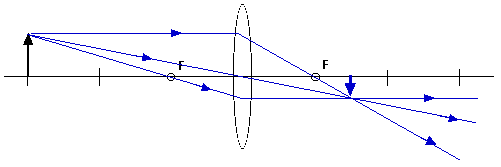
This produces an image that is about 15 cm from the lens.
In the second diagram, the object is 20 cm from the lens and an image is produced 20 cm beyond the lens.
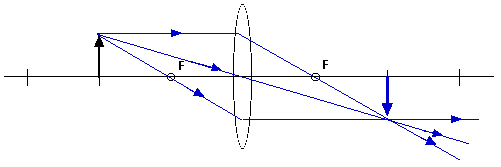
This means that decreasing the object distance will increase the image distance. Therefore, changing from an object very far away to an object nearby means the image distance -- the distance from the lens to the film -- will increase. So the lens must be moved away from the film.
3. A compound microscope
a) forms a virtual image with its objective lens; this is then viewed with the eyepiece.b) forms a real image with its objective lens; this is then viewed with the eyepiece.
c) forms a virtual image with its objective lens which can be projected onto a ground glass or viewing screen.
d) forms a virtual image which is right-side-up and enlarged.
4. A compound microscope
a) uses a diverging lens as an objective lens to form a virtual image.b) uses a converging lens as an objective lens to form a virtual image.
c) uses a diverging lens as an eyepiece lens to form a virtual image.
d) uses a converging lens as an objective lens to form a real image.
5. The eyepiece in a compound microscope is used
a) to project a real image onto a ground glass or viewing screen.b) as a simple magnifier to view the real image produced by the objective lens.
c) as a converging lens to re-invert the image so it is right-side-up.
d) to invert the image a second time to make it right-side-up.
6. The objective lens in an astronomical telescope forms
a) a virtual image at infinity.b) a virtual image beyond the eyepiece.
c) a real image at infinity.
d) a real image that is viewed by the eyepiece.
7. The eyepiece in a telescope forms
a) a virtual image that is right-side-up.b) a virtual image that can be comfortably viewed by the eye.
c) a real image that can be projected on a viewing screen.
d) a real image that is right-side-up.
8. Vision for a nearsighted eye can be improved with glasses that are
a) convergingb) diverging
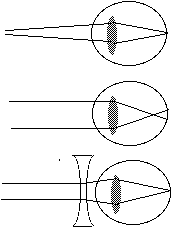
9. Vision for a farsighted eye can be improved with glasses that are
a) convergingb) diverging

10. The "near point" of an eye is
a) the farthest distance that eye can comfortably see.b) always 25 cm
c) the closest distance that eye can confortably see.
d) infinity.
11. The "far point" of an eye is
a) the farthest distance that eye can comfortably see.b) always 25 cm
c) the closest distance that eye can confortably see.
d) infinity.
![]()
(C) 2003, Doug Davis; all rights reserved